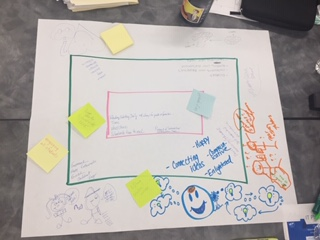Here’s how it works:
1. Grab a large piece of chart paper and create two squares nesting within each other as shown in my sketchnote to the left.
2. Place the chart paper on the tables your teachers will work at and add a handful of colorful markers and sticky notes.
3. Decide how teachers will interact with each other. The premise is simple: Each square on the chart represents a different level of thinking, beginning with the outermost square. As we move inward, teachers literally need to lean in to jot their thinking and ultimately, share their reflections with others.
Here's an example:
I recently used this format when working with the literacy team at a local school district. Charged with the task of choosing the district’s next literacy curriculum, we were meeting to create a vision for our work and launch our exploration. I used this box method to foster conversation and collaboration and help teachers identify what matters most for their students:



Here’s why this activity works so well:
I recently used this format when working with the literacy team at a local school district. Charged with the task of choosing the district’s next literacy curriculum, we were meeting to create a vision for our work and launch our exploration. I used this box method to foster conversation and collaboration and help teachers identify what matters most for their students:
- First, I asked teachers to draw their vision of what a successful and happy reader would look like at the end of the school year in their classrooms in the outermost square. What would they look like? How would they feel? What would they be doing? I encouraged teachers to label their images with words that represented their thinking. Once complete, teachers shared their images with the others at their table and started thinking broadly on what they hoped their curriculum would accomplish.
- Next, I asked teachers to think about what they would need in order to make that vision a reality. Teachers wrote things like more books, smaller class sizes, professional development, literacy station materials and more in the next inner square and had a conversation about their needs and wishes for the curriculum.
- Finally, teachers moved to the innermost square to synthesize their thinking and create a shared vision for their future curriculum based on the kinds of readers and writers they hoped to have and the things they would need to get there. We ended by sharing our key take-aways with the whole group, leading to more substantial conversations about how they would evaluate curriculum moving forward based on their visions.
Here’s why this activity works so well:
- First, there is very little risk. The spaces to write in are small, prompting teachers to write quick sketches and phrases to lead conversations in small groups.
- Second, the design of the chart requires teachers to lean into the page so they can better reach the next inner square and this proximity facilitates conversation, scaffolding the content to deeper levels of thinking.
- Finally, the innermost circle requires teachers to not only share their thinking, but to synthesize it into one group take-away that the whole group might benefit from.
There are endless variations to this activity. Here are just a few of the ways I have tried it:
- To reflect on videos of instruction
- To respond during book studies
- When introducing a new topic
- To brainstorm solutions to challenges
Now, there are two more ideas that elevate this activity even more: moving the page and moving our feet.
Moving the Page: After writing on the outermost square, have teachers shift the paper clockwise so that they are viewing someone else’s writing. This helps them learn about their tablemate’s thinking and gain a new perspective. You could even rotate the chart after writing on the middle square as well. The turning of the page literally provides teachers with a new perspective to consider and then converse about. This works particularly well when the first square has teachers writing about questions and challenges. Then, once teachers rotate the chart, they can attempt to answer the questions or solve the challenges now in front of them, usually generating good conversation.
Moving our feet. Rather than rotate the chart, teachers can move around to the other tables in the room and browse their colleagues’ thinking. They should grab a pack of sticky notes from the table and then add their own ideas to the charts for the group to consider when they return, elevating the level of collaboration even more.
Well, there you have it. This simply, no-preparation activity has the potential to spark conversation and elicit deeper thinking with two squares, markers and a few sticky notes. How might you adapt this to fit your next professional learning session?
Moving our feet. Rather than rotate the chart, teachers can move around to the other tables in the room and browse their colleagues’ thinking. They should grab a pack of sticky notes from the table and then add their own ideas to the charts for the group to consider when they return, elevating the level of collaboration even more.
Well, there you have it. This simply, no-preparation activity has the potential to spark conversation and elicit deeper thinking with two squares, markers and a few sticky notes. How might you adapt this to fit your next professional learning session?





Love this
ReplyDeleteThank you, Stephanie. We have a district PD coming up and this will be a wonderful way to get teachers in other buildings communicating their thoughts on our new curriculum and sharing some tips to success.
ReplyDelete